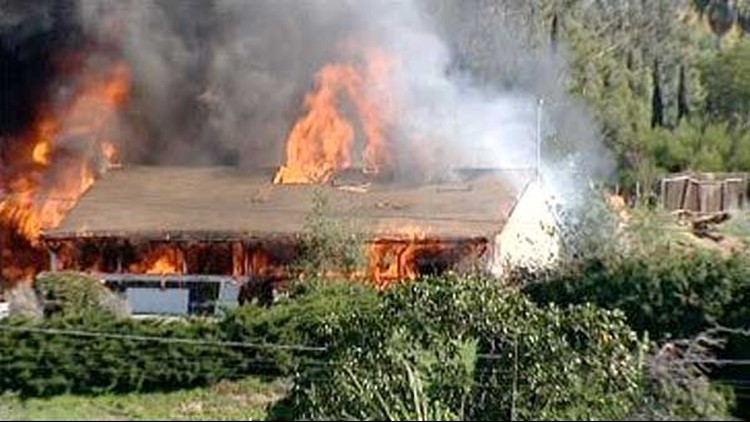Evacuated residents may be allowed to return to their homes late Thursday afternoon or early Thursday evening.
ESCONDIDO (CNS) - A North County home packed with illegal explosives and weapons was demolished Thursday in a spectacular controlled burn deemed the only safe way to get rid of the volatile chemicals.
A bomb squad team remotely ignited the home in the 1900 block of Via Scott in unincorporated Escondido just before 11 a.m. Heavy smoke soon poured out of the roof of the dwelling, followed by intense flames several stories high.
A few minutes later, the entire house was furiously burning, along with a few nearby patches of shrubbery, and loud popping noises and occasional blasts reverberated through the largely evacuated neighborhood just west of Interstate 15 and north of State Route 78.
Within 45 minutes, the inferno had diminished to campfire-sized flames licking the scorched pile of rubble and blackened structural remnants where the single-story house had stood.
San Diego County Sheriff Bill Gore praised the unusual demolition, which necessitated large-scale evacuations and a highway closure, as an unqualified success.
"I don't think this could have gone any better," Gore told reporters.
Dozens of air-quality sensors set up through the neighborhood detected brief spikes in pollution, followed by safe conditions, officials said.
The various pops and bangs that rang out during the blaze were apparently the sounds of detonating ammunition and hand grenades that were among the illegal stockpile of weapons and bomb-making materials discovered in and around the home three weeks ago, sheriff's spokeswoman Jan Caldwell said.
George Djura Jakubec, 54, who lived in the house with his wife for about four years, pleaded not guilty Monday to eight federal criminal counts and was ordered held without bail.
The Serbian native is accused of manufacturing and possessing destructive devices, as well as robbing three banks and trying to rob a fourth over the past two years. Authorities have disclosed no motive for the defendant's alleged bomb-making activities.
The charred rubble and ashes of the incinerated structure were likely to smolder through the remainder of the day, but residents of about six dozen surrounding evacuated addresses were expected to be able to return to their homes in the mid-afternoon, Caldwell said.
Authorities refrained from spraying water on the embers of the destroyed house so as to avoid washing any pollution into storm drains or surrounding soil, according to Gore.
"We're hoping the fire will just put itself out," he said.
Interstate 15, which was closed between SR-78 and Centre City Parkway about an hour prior to the fire, was fully reopened shortly after noon.
On Friday, crews will pick up some of the charred rubble to test for remaining explosive chemicals and other hazardous substances, though it was considered "highly unlikely that there's any (remaining) toxicity," the spokeswoman told news crews.
The controlled burn resulted in temperatures of 1,500 to 1,800 degrees, enough heat enough to neutralize all the dangerous chemicals discovered throughout it, said San Marcos Fire Chief Todd Newman, one of the supervisors of the operation.
Thorough cleanup efforts at the site are expected to begin Monday.
The fire was originally scheduled to begin about 9 a.m. but was postponed to allow an atmospheric "inversion layer" to break up so the resulting smoke would billow straight up in the air before dissipating, said Robert Kard, director of the San Diego County Air Pollution Control District.
That best-case scenario played out, with the black plume rising some 2,500 feet before drifting away to the east, the sheriff said.
After the controlled fire got under way, Michael Martinez, who lives across I-15 from the burn site, said he was "not too worried" about his own home, though the column of smoke seemed to be headed toward it.
"I'm more worried about storage lockers nearby -- that (Jakubec) might not have stored all his explosives in one place," Martinez said. "I hope investigators look into that.'
The hoard of hazardous compounds -- including substances often used by suicide bombers and other terrorists -- was "the largest quantity of these types of homemade explosives (ever found) at one place in the United States," Deputy District Attorney Terri Perez said at Jakubec's initial court appearance in the case.
Perez told a judge the defendant had turned his home into a "bomb factory."
Jakubec's alleged activities came to light Nov. 18, when a landscaper, 49-year-old Mario Garcia of Fallbrook, stepped on and detonated some type of explosive in Jakubec's back yard, suffering serious injuries.
The defendant allegedly admitted to robbing three banks as well as keeping explosives and other weapons at his home.
Investigators found at least nine pounds of unstable explosive compounds in the unkempt house, which was strewn throughout with piles of boxes, books, tools, plastic bottles, electronic components and other clutter. Much of the illicit chemical cache was in glass jars, and some apparently had spilled on the floor, officials said.
At a hearing on Wednesday, FBI special agent and bomb technician James Verdi testified that explosives were found in the home in "amounts we've never seen before" -- either domestically or internationally.
A coffee table was covered with improvised detonators and chemical compounds so sensitive that even papers on it couldn't be moved, Verdi told a judge.
Federal prosecutor Rees Morgan said there was evidence of other past unintended explosions at the residence, such as blown-out windows and walls and ceilings bowed outward and upward.
The owner of the rental property reportedly will not be reimbursed by the government, although it was unclear if the loss of the house might be covered by insurance.
The discovery of the stockpile of explosives prompted Gov. Arnold Schwarzenegger to declare the San Diego region a disaster area. On Tuesday, the county Board of Supervisors ratified a local emergency declaration that allowed authorities to torch the home.
In addition to evacuations and road closures, preparations for the burn included erecting a 16-foot-high metal-framed barrier, removing vegetation and fences that could have caught fire, and installing a portable weather station on the roof of nearby Escondido Fire Department Fire Station 3 to get real-time readings.
The elaborate operation may well wind up serving as a teaching tool for dealing with similarly acute hazardous-materials problems in the future, the sheriff said.
"If an incident like this ever happens again in the United States, this is the example they'll look to," Gore told reporters during an afternoon briefing. "This is the textbook for how to do it. Something on this scale hasn't been done before."
This is a breaking news update. The previous story is below.
SAN DIEGO (AP/CBS 8) — A judge on Wednesday refused to delay the destruction of a suburban San Diego home after a prosecutor described a detonator-strewn coffee table as "ground zero" of a home so packed with explosives that it was far too dangerous to enter.
U.S. District Judge Larry Burns' ruling cleared the way for authorities to burn the home, located on 1954 Via Scott in Escondido, to the ground on Thursday.
Attorneys for the resident, George Jakubec, sought a delay to allow time to collect evidence from the home, including notes scribbled on graph paper and a hardcover book about mining.
Burns said he accepted the testimony of FBI bomb expert James Verdi that it would be "very irresponsible" to allow anyone in the Escondido home, north of San Diego.
"It says a lot to me that he doesn't want to go back in," Burns said. "I frankly think it's just too dangerous."
Defense attorney Michael Berg asked the FBI expert if Jakubec, his wife and their dog were "just lucky" to escape injury in their four years at the rented home.
"Extremely lucky," Verdi replied.
Jakubec sat quietly in an orange jumpsuit during the hearing and did not address the judge. His attorney did not say how the mining book or scribbled notes might help his client.
"He indicated to me that there were notes taken on the graph paper that he wanted to assist in his defense," Berg said.
Jakubec, a 54-year-old unemployed software consultant, has pleaded not guilty to charges of making destructive devices and robbing three banks. Authorities have not said why he had the material.
About 40 bomb experts and eight national laboratories have been working on a plan to burn down the home on a half-acre lot near a busy, eight-lane freeway in an unincorporated area north of San Diego.
Crews have built a 16-foot fire wall to protect the closest homes. Scores of nearby residents will be evacuated, and officials plan to close down a section of Interstate 15 during the burn, which will be monitored by more than a dozen air pollution sensors.
San Diego County Sheriff Bill Gore said Thursday's highly controlled burn should take one to four hours.
Bomb technicians last went into the home on Monday to search for the mining book on the coffee table — as Berg requested — but didn't find it, prosecutors said.
The table was cluttered with documents and laced with numerous detonators and highly unstable Hexamethylene triperoxide diamine, or HMDT, which can explode by someone stepping on it.
"The coffee table is what the bomb squad calls ground zero," Assistant U.S. Attorney Rees Morgan told the judge. "This really was an assembly line for detonators being created in his house ... It is a no-go zone."
Prosecutors contend the only way to safely dispose of the explosives is to burn down the home, which is so cluttered with unstable chemicals that it can not be safely entered — not even by bomb-disposing robots.
Nearly every room in the suburban, ranch-style house is packed with piles of explosive material and other items related to making homemade bombs, prosecutors said.
Berg said Jakubec believes there are journals and other papers inside that would explain why he had the explosive materials.
The lawyer said authorities have not told the defense whether they retrieved those items, and they should be allowed to see the government's finding before the property is destroyed.
Bomb squad officers who inspected the property believe Jakubec has manufactured so many devices for so long that "even he has forgotten the location and type of explosives stashed throughout the property," prosecutors said in a court filing.
Bomb squad officers say they found the same types of chemicals used by suicide bombers and insurgents in Iraq and Afghanistan. The materials included Pentaerythritol tetranitrate, or PETN, which was used in the 2001 airliner shoe-bombing attempt as well as airplane cargo bombs discovered last month by authorities.
The chemicals were found after a gardener accidentally set off an explosion nOV. 18 at the home by stepping on what authorities believe was a byproduct of highly unstable Hexamethylene triperoxide diamine, or HMTD.
Investigators said Jakubec admitted dumping the highly unstable substance in the backyard. Even the byproduct of the HMTD chemical process is volatile enough to cause an explosion when gravel is scuffed together, they said.
A bomb squad officer set off another minor explosion in the same area of the yard but escaped unscathed, prosecutors said.
Berg argued that Jakubec, his wife and dog lived in the residence unharmed for years, but Sheriff Bill Gore says there is evidence to the contrary.
"There evidently had been several minor explosions in the past. A sliding glass door had been blown out, windows had been blown out and the fact that Mr. Garcia was severely injured... so the fact that Mr. Jakubec and his wife had not been hurt, I think they are very fortunate," Sheriff Gore said.
Jakubec remains jailed without bail and could face 32 to 132 years in prison if convicted.
Information contributed by News 8 Reporter Rekha Muddaraj.
EVACUATION & SHELTER IN PLACE PLANS (click images to enlarge)
Copyright 2010 The Associated Press.






